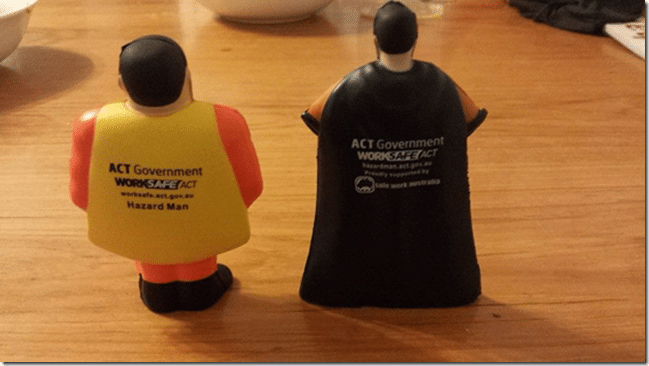When You Don’t Know About Safety Hire a Marketing Agency
 It seems to be the trend that when you don’t know about safety you engage a marketing agency. This is certainly the case with Melbourne Metro (Dumb Ways to Die) and with Worksafe ACT (Hazardman). The real problem with agencies that don’t know safety is that that rarely consider the trade offs and by-products of spud-head ideas. They rarely consider the hidden messages, unconscious priming or ‘hidden curriculum’ in their promotion. What eventuates is an emphasis on marketing rather than a sensible message in safety. Let’s review both examples.
It seems to be the trend that when you don’t know about safety you engage a marketing agency. This is certainly the case with Melbourne Metro (Dumb Ways to Die) and with Worksafe ACT (Hazardman). The real problem with agencies that don’t know safety is that that rarely consider the trade offs and by-products of spud-head ideas. They rarely consider the hidden messages, unconscious priming or ‘hidden curriculum’ in their promotion. What eventuates is an emphasis on marketing rather than a sensible message in safety. Let’s review both examples.
Hazardman
The Hazard Man campaign in 2013, the year the ACT regulator was up to their neck in a string of fatalities in construction. An enquiry was held resulting in the Getting Them Home Safely Report. Since the report little has been done in a cultural sense, very little has changed, yet regulation and policing has increased. The recommendations regarding proactive culture training have not been implemented despite an independent review into a highly successful model. Instead out of the blue comes this Hazardman campaign
Hazardman is endorsed by Safe Work Australia.
Hazard man is an indoctrination campaign that targets school children with the following messages:
· No consideration of childhood learning development or the mixing of abstract concepts to school children (eg. Understanding construction sites )
· Telling school children not to lift 40kg bags on construction sites
· Only superheros can identify and manage hazards
· Women are weak and need Hazardman to rescue them from hazards
· Stereotypes of heroes (muscles and breasts) are endorsed by the campaign
· The regulator is a ‘dork’ and is identified by a checklist
· There is no discussion of risk in the campaign
· There is no discussion of other major risks to high school children such as social media risk etc rather, the emphasis is on petty safety risks on building sites
· Complacency is represented as an ‘evil’ rather than the result of functioning automatic
· Evil is represented by someone titled ‘Dr’ promoting the idea that higher education and intelligence is associated with being evil
· A lack of safety a secret campaign by evil forces
· Safety is about slips, trips and falls; phones and manual handling
· Saving people from hazards is heroic, particularly helping women who can’t see hazards
· A focus on safety officers as safety heroes rather than safety as everyone’s responsibility
· Workers must be ‘rescued’ from complacency
· Telling people what they already know rather than trying to understand why people make judgments and decisions
· Safety messages are conveyed by text and telling rather than subtle unconscious messages conveyed in images, symbols and graphics
Of course this list can be extended but shows just how skewed the safety message can become when you don’t understand safety and seek solutions to safety issues with marketing agencies. Of course, what indoctrination campaign in schools would be complete without a competition and giveaway dolls???
I can’t think of a better campaign to inoculate children against a serious consideration of safety than this campaign. When the regulator thinks that superficial messages are the essence of safety, what hope have we got. Did the regulator consult educators (to link message to child development) about this campaign? Did they consult the ACT Education Department? No, this campaign is not endorsed by the Education and Training Department. Yet, the Hazardman dolls are endorsed by the ACT Government and clearly aimed at Primary School children despite the fact that the Minister claims this is not the case. What upper High School children identify with cartoon dolls?
Dumb Ways to Die
I had an interesting note from someone who suggested there was no aspect of suicide connected to the Dumb Ways to Die campaign, how strange, let’s look at the cute video. What are the dumb ways to die:
- Self inflicted fire to your hair
- Intentionally poke a stick at a Grizzly Bear
- Intentionally eat out of date medications
- Dunk your genitals in a Piranha infested water
- Electrocute your self using a kitchen toaster
- Do your own electrical work
- Teach your self how to fly a plane
- Eat toxic food
- Invite a psycho killer into your house
- Upset a drug dealer
- Take your helmet off in outer space
- Hide in a clothes dryer
- Play with snakes
- Sell both kidneys on the Internet
- Eat super glue
- Attract hunters to shoot you
- Disturb a wasp’s nest
- Finally, stand on the edge of a train platform
- Drive through a level crossing
- Play on train tracks
Strange all these activities are not presented as accidental but rather intentional, it is a video about suicide. So, the evidence is there, the problem is not accidental death but suicide. I have written about this before, this is not a safety campaign but an anti-suicide campaign.
https://safetyrisk.net/more-dumb-ways-to-suicide/
https://safetyrisk.net/dumb-ways-to-discourse-a-failed-approach-in-safety/
https://safetyrisk.net/new-safety-videodumb-ways-to-die/
https://safetyrisk.net/dumb-ways-to-measure-effectiveness/
https://safetyrisk.net/dumb-ways-to-die-and-a-strange-sense-of-success/
So here we have yet another case of trying to tackle a problem by going to a marketing agency. What is worse then judging success not by changes to numbers of suicides or changes to sub-cultural attitudes to suicide on the Melbourne Metro network but by numbers of hits on the video? How strange what an odd measure of success. You can get such success by using ‘click farms’ . Even if the clicks are genuine what a strange way to measure success. Released at exactly the same time as the Dumb Ways to Die campaign (90 million hits) was the video of Wrecking Ball with Miley Cyrus nude (720 million hits). Also launched following the enclosure of the West Gate Bridge . So don’t consider the ethics of what defines success, just measure hits and that is success. Well nude Miley is obviously nine times more successful than Dumb Ways to Die. Since when did hits on the Internet become a way of judging ethical value?
Once these two agencies Melbourne Metro and Worksafe ACT have so much sunk cost in these campaigns will be see them get reconsidered, not likely. Neither are safety campaigns but indoctrination campaigns. Neither are safety campaigns but marketing campaigns. Neither tackle the real issue but superficial issues. Neither have changed the culture of safety but have made it more confusing and distorted the safety message with propaganda.
How to Promote a Safety Message
The power of words, framing, pitching and priming is in the effect on the unconscious. Marketers know this but unfortunately don’t know safety. So we end up with powerful marketing of toxic messages rather than safety messages that are powerful and culture changing. Real leading in safety knows much more than the superficiality of messages but rather the hidden effect of messages on the unconscious in followers. Here are a few things to consider in promoting a motivational and consistent safety message:
- Consider not just the surface (superficial) message in any safety campaign but the hidden message
- Consider more the trade offs and by-products in safety messages (perhaps start by reading Amalberti, Navigating safety, Necessary Compromises and Trade-Offs.)
- Understand that language and words contain an embedded discourse (transmission of power and values) Perhaps read Newberg, Words Can Change Your Brain or; Fairhurst The Power of Framing.
- Maybe consult a broad range of people in the business of safety before jumping into a marketing agency
- Keep away from absolutes, mechanistic numerics and punitive messages
- Promote positive safety messages that consider the essentials of motivation (belonging, truth effectiveness, value effectiveness and control effectiveness)
- Don’t be enticed by behaviourist philosophies or simplistic intrinsic/extrinsic rewards
- Consider the symbols, images, graphics and unconscious messages in any campaign
- Consult workers and trial/pilot any campaign and see if it has any effect on cultural attitudes and values
- Review safety messages regularly and be prepared to dump ideas that don’t work
There is much more to learn about the social psychology of risk and this list is far from exhaustive. Much more can be learned in the Post Graduate Program at ACU (http://www.humandymensions.com/post-graduate-studies). There are still places to enroll and if you are interested contact the Convenor Brad Markham Brad.Markham@acu.edu.au




Do you have any thoughts? Please share them below